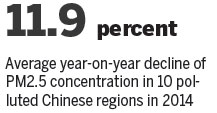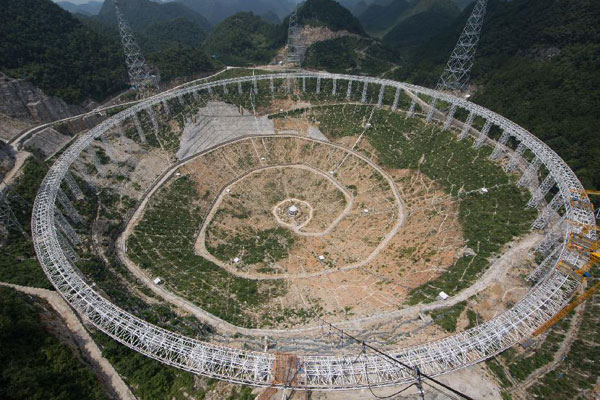Efforts to clean air bear fruit
Updated: 2015-08-03 07:36
By Lan Lan(China Daily)
|
||||||||
Most Chinese regions with pollution problems made significant progress last year in their efforts to improve air quality because of regulators' measures to curb smog, a report released on Friday said.
The average PM2.5 concentration in 10 polluted Chinese regions declined by 11.9 percent year-on-year in 2014, said the report from the Clean Air Alliance of China, a Beijing think tank.
PM2.5 refers to tiny particles in the air 2.5 micrometers in diameter or smaller. Such particles can penetrate deep into the lungs.
Despite the progress in many areas, the nation's capital was the least successful of the 10 regions. Beijing's concentration of PM2.5 declined by 4 percent, the lowest decrease among the regions, while Shanxi province saw the largest - 16.7 percent - thanks to slumping coal production there.
Tonny Xie, a director of the secretariat for the China Air Alliance of China, said Beijing's local government has made great efforts to clean its air, but the city faces a tougher challenge with its air pollution problem because the pollution sources are outside the city.
"Both Tianjin's and Hebei's PM2.5 concentration decline was more than average," Xie said, referring to the municipality and province that border Beijing. "With the new policies put in place, air quality in the Beijing-Tianjin-Hebei region is expected to be greatly improved in coming years."
The capital's pollution is of particular concern since Beijing and Zhangjiakou, Hebei province, were selected on Friday as the co-host cities for the 2022 Winter Olympics.
According to the Air Pollution Prevention and Control Action Plan issued by the State Council in 2013, the concentration of PM2.5 in the Beijing-Tianjin-Hebei region should be reduced by 25 percent by 2017.
Shenzhen, Guangdong province, is the only Chinese city with a population of over 10 million that has reached a healthy level of PM 2.5 concentration, lower than 35 micrograms per cubic meter.

"Megacities face more challenges in curbing pollution. Shenzhen has succeeded in two tasks simultaneously - managing pollution sources and optimizing industrial structure and energy mix, providing a development model for other cities," he said.
Also, Xie said, the PM2.5 concentration of some regions in Hunan and Hubei provinces, Chongqing municipality and Chengdu, the capital of Sichuan province, have surpassed the traditional manufacturing base such as the Yangtze River Delta and the Pear River Delta.
But the report also warned that the PM10 pollution - that with particles with a diameter of 2.5 to 10 micrometers - in some cities in the middle, northeastern and western regions has become worse in the past year.
Wang Lisha, senior project manager of the Clean Air Alliance, said that in addition to pollution treatment, industrial restructuring and vehicle emissions are equally important.
The alliance was created by 10 Chinese technical institutions in the field of air quality, including Tsinghua University, and with support from the Energy Foundation China.
lanlan@chinadaily.com.cn
- Remains of Chinese guard killed in Somalia attack return home
- Gala promotes gender equality
- Trafficked woman appeals to be left alone, continue her life
- Wreckage discovery shouldn't disrupt search: MH370 families
- 3,000 students attend pre-exam session in huge hall
- 38.7b yuan in State assets recovered in campaign

 Remains of Chinese guard killed in Somalia attack return home
Remains of Chinese guard killed in Somalia attack return home
 Top 10 international destinations for Chinese millionaires
Top 10 international destinations for Chinese millionaires
 Rainstorm affects 940,000 in South China
Rainstorm affects 940,000 in South China
 Do you take all your paid leave?
Do you take all your paid leave?
 National Art Museum of China displays Polish folk art
National Art Museum of China displays Polish folk art
 Chinese soldiers in parades
Chinese soldiers in parades
 US Marines Corpos soldiers demonstrate martial arts
US Marines Corpos soldiers demonstrate martial arts
 World's largest radio telescope being built
World's largest radio telescope being built
Most Viewed
Editor's Picks

|

|

|

|

|

|
Today's Top News
Remains of Chinese guard killed in Somalia attack return home
Professor accused of spying out on bond
Chinese defense concerned about US moves in South China Sea
Chinese named in test-taking scam deported from US
Baidu to buy back shares worth $1b
Former military leader Guo Boxiong expelled from CPC, to face justice
Pair to face poaching charges related to death of popular lion
Amazon wants air space for delivery drones
US Weekly

|

|






